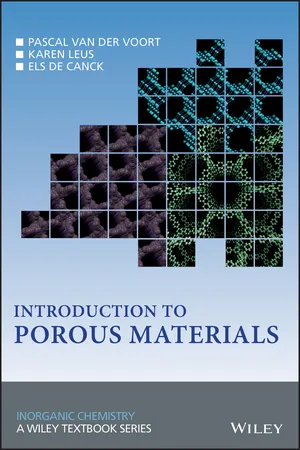
- English
- ePUB (mobile friendly)
- Available on iOS & Android
Introduction to Porous Materials
About this book
The first comprehensive textbook on the timely and rapidly developing topic of inorganic porous materials
This is the first textbook to completely cover a broad range of inorganic porous materials. It introduces the reader to the development of functional porous inorganic materials, from the synthetic zeolites in the 50's, to today's hybrid materials such as metal-organic frameworks (MOFs), covalent organic frameworks (COFs) and related networks. It also provides the necessary background to understand how porous materials are organized, characterized, and applied in adsorption, catalysis, and many other domains. Additionally, the book explains characterization and application from the materials scientist viewpoint, giving the reader a practical approach on the characterization and application of the respective materials.
Introduction to Inorganic Porous Materials begins by describing the basic concepts of porosity and the different types of pores, surfaces, and amorphous versus crystalline materials, before introducing readers to nature's porous materials. It then goes on to cover everything from adsorption and catalysis to amorphous materials such as silica to inorganic carbons and Periodic Mesoporous Organosilicas (PMOs). It discusses the synthesis and applications of MOFs and the broad family of COFs. It concludes with a look at future prospects and emerging trends in the field.
- The only complete book of its kind to cover the wide variety of inorganic and hybrid porous materials
- A comprehensive reference and outstanding tool for any course on inorganic porous materials, heterogeneous catalysis, and adsorption
- Gives students and investigators the opportunity to learn about porous materials, how to characterize them, and understand how they can be applied in different fields
Introduction to Inorganic Porous Materials is an excellent book for students and professionals of inorganic chemistry and materials science with an interest in porous materials, functional inorganic materials, heterogeneous catalysis and adsorption, and solid state characterization techniques.
Frequently asked questions
- Essential is ideal for learners and professionals who enjoy exploring a wide range of subjects. Access the Essential Library with 800,000+ trusted titles and best-sellers across business, personal growth, and the humanities. Includes unlimited reading time and Standard Read Aloud voice.
- Complete: Perfect for advanced learners and researchers needing full, unrestricted access. Unlock 1.4M+ books across hundreds of subjects, including academic and specialized titles. The Complete Plan also includes advanced features like Premium Read Aloud and Research Assistant.
Please note we cannot support devices running on iOS 13 and Android 7 or earlier. Learn more about using the app.
Information
1
Nature's Porous Materials: From Beautiful to Practical


1.1 Living Porosity
1.1.1 Butterflies

Table of contents
- Cover
- Table of Contents
- Preface
- About the Authors
- 1 Nature's Porous Materials: From Beautiful to Practical
- 2 Theory of Adsorption and Catalysis: Surface Area and Porosity
- 3 Zeolites and Zeotypes
- 4 Silica, A Simple Oxide – A Case Study for FT–IR Spectroscopy
- 5 Ordered Mesoporous Silica
- 6 Carbons
- 7 The Era of the Hybrids – Part 1: Periodic Mesoporous Organosilicas or PMOS
- 8 Era of the Hybrids – Part 2: Metal–Organic Frameworks
- 9 Beyond the Hybrids – Covalent Organic Frameworks
- Index
- End User License Agreement